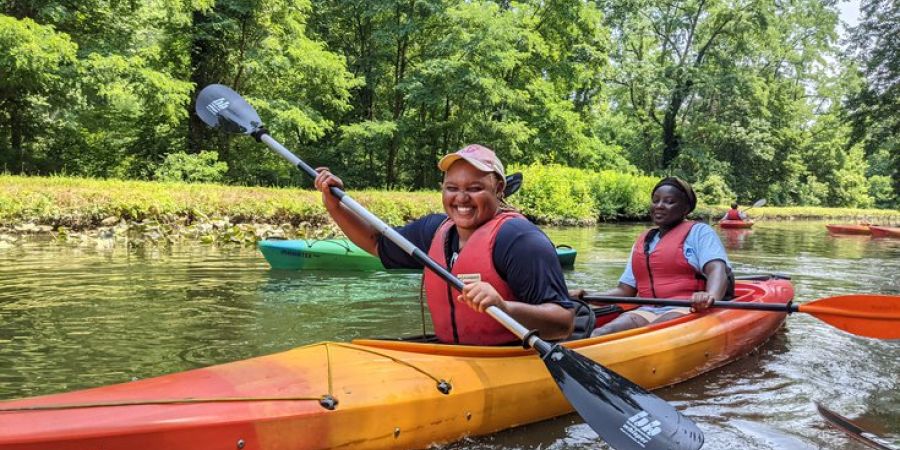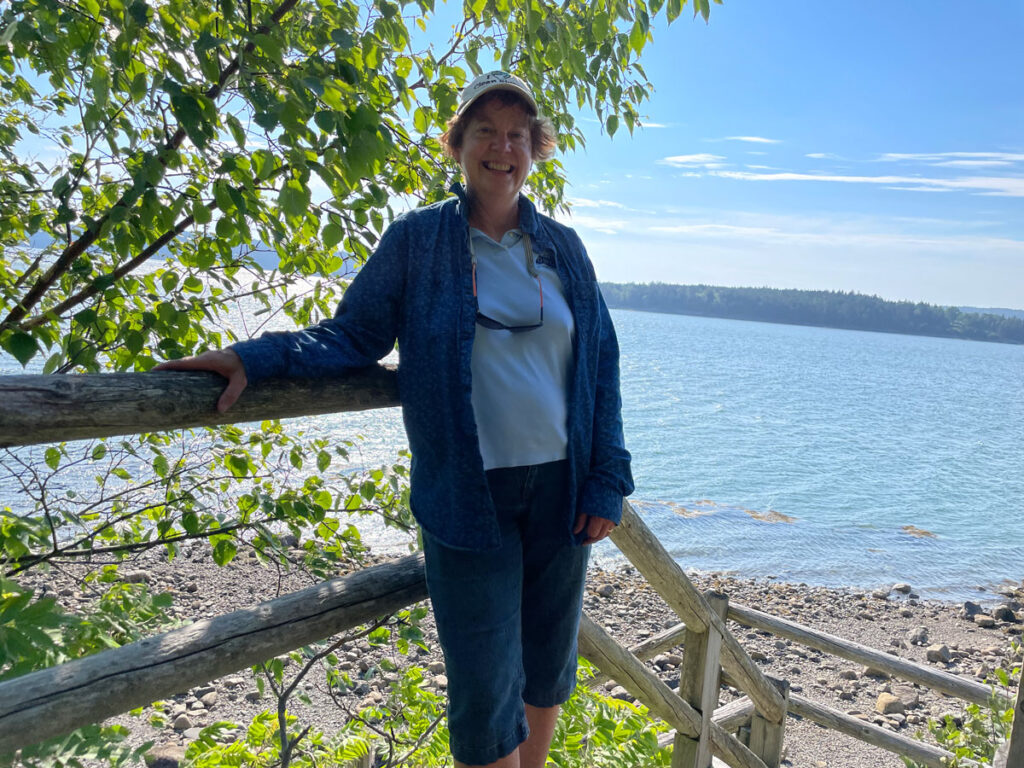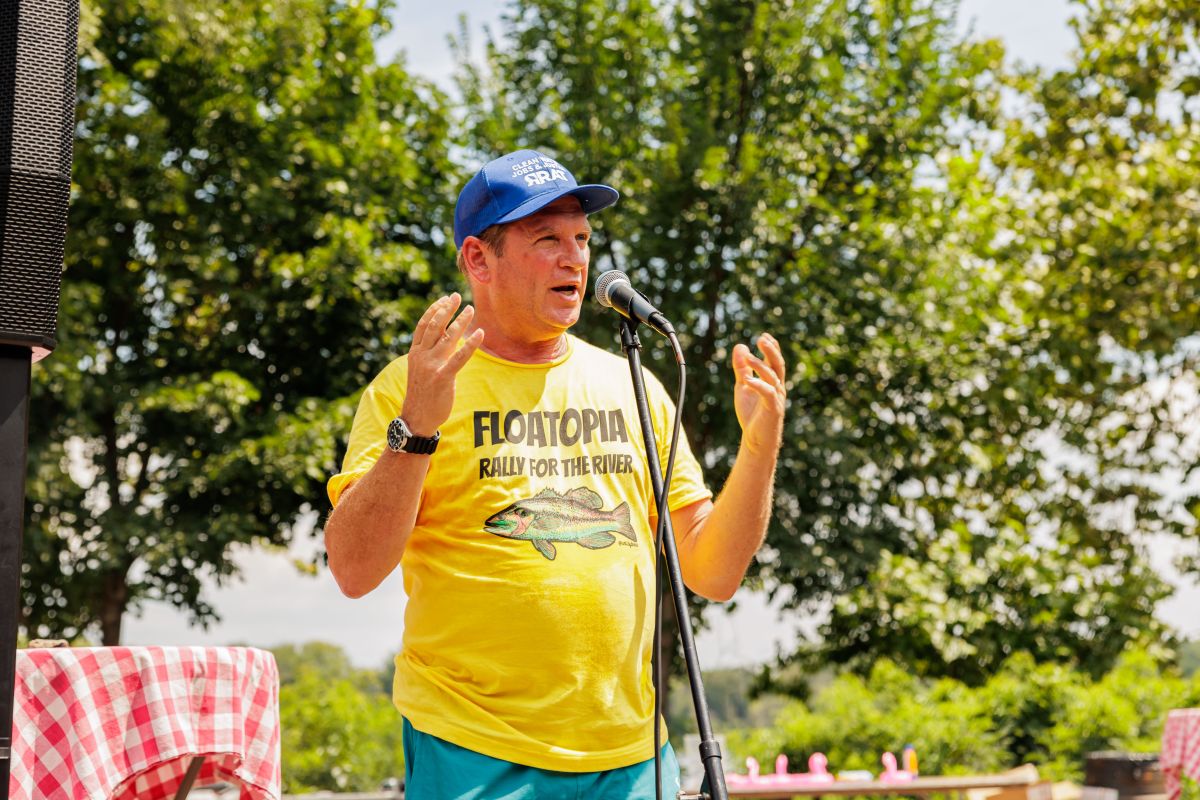Blog

National Experts Weigh in on Vision for a Swimmable Delaware (Part 1)
With temperatures in the 90s and summer in full swing, folks in our region are looking for opportunities to get wet! For those with the resources, that could mean a trip down the shore, but what are the opportunities right here at home? Regardless of means, the desire and demand for accessible on-water and in-water recreational opportunities along Philadelphia’s own natural waterways is strong. Helping to ensure those opportunities are available in ways that are equitable and safe is year-round work, as many readers of this blog understand first-hand.
Case in point: Last fall, Philadelphia City Council’s Committee on Commerce and Economic Development held a hearing on how the region’s waterways are faring, how the city could be taking advantage of federal infrastructure funding to improve the water quality of the Delaware and Schuylkill Rivers for public recreational use, and what we can learn from the experience of other urban waterways. The Committee heard testimony from the Philadelphia Water Department and from a group of experts convened by Tim Dillingham, executive director of the American Littoral Society, a William Penn Foundation grantee. The group included: Layla Bibi of the Eastern Atlantic States Regional Council of Carpenters; Maggie Flanagan, chair of the education subcommittee of the Harbor Operations Safety and Navigation Committee of the Port of New York and New Jersey; Lawrence Jones, CEO, Richard Allen Preparatory School; Andy Kricun, senior fellow at the U.S. Water Alliance and former head of Camden County’s water utility; and Nancy Stoner, president, Potomac Riverkeeper Network.
Councilmember Mark Squilla opened the hearing by acknowledging that of the Delaware River’s 330 miles, only 27 miles are not designated for primary contact or full recreational use because of the presence of harmful bacteria from combined sewer overflow (CSO). Those 27 miles of river run through Philadelphia, Chester, and Camden – communities near the waterways where average household incomes hover around $28,000, “which means the areas with lesser means have less usable water,” as Councilmember Squilla reported. Every year billions of gallons of stormwater mixed with raw sewage is collected by the region’s antiquated infrastructure and funneled, untreated, directly into creeks, streams, and rivers. (See a new report on this issue by PennEnvironment, also a Foundation grantee.)
The experts addressed the need to correct that inequity and the urgency to accelerate progress in managing bacterial contamination and CSO, particularly given the increasing impact of climate change. They also spoke about the availability of new federal infrastructure dollars to support this work as part of Philadelphia’s Green City, Clean Waters plan and other initiatives. The upside of these efforts, they explained, not only creates more swimmable, fishable, and accessible waterways but also generates new clean jobs, enhances communities’ climate resilience, plays a role in the health and education of our young people and families, and supports local economic development. And, they emphasized, this kind of progress is attainable, as evidenced by recreational waterways in neighboring areas like New York City and Washington, D.C.
We’ve checked back in with some of these experts to explore more of the work behind their testimony last fall and get an update on what’s next in the pursuit of swimmable, fishable, recreational waterways for all in the Philadelphia region. Insights from Tim Dillingham and Nancy Stoner are shared here. Additional Q&As will be shared in a second blog post in a few weeks.
Tim Dillingham, executive director of the American Littoral Society
WPF: In your testimony you stress the opportunity we have to achieve waterways that are SAFE - swimmable, accessible, fishable, and equitable. The U.S. Clean Water Act gives us water quality standards and regulatory tools to address swimmable and fishable, but what is an accessible and equitable urban waterway? How do you envision that, particularly for a stretch of water like the urban Delaware estuary?
TD: Yes, the Clean Water Act (CWA) promised that by 1982 all waterways would be swimmable and fishable, but there are 27 miles of the Delaware River between Trenton, Philadelphia, Camden, and Wilmington, where it’s the only stretch that you can’t swim in. Bordering those 27 miles are Black and brown communities – people who have lived with environmental injustices for years. It’s obviously long past time to change that.
There are two parts to being an accessible waterway: first, water quality can’t be a barrier to swimming, fishing, paddling, or wading in the river, and second, people have to have the ability to use the water, to get to it, as others can. For example, I live 50 miles upriver from Philadelphia, and here there are state parks on either side of the Delaware with accessible boat launches and visitor facilities; those amenities and access points aren’t as prevalent along the 27 miles that go through Philadelphia.
In fact, there is a long history of disinvestment in these communities due to environmental injustice, racism, and the de-valuation of the riverways themselves. These communities are behind in terms of having resources that are centered on valuing the rivers, the experiences that people can have in, on, and near them, and the benefit those experiences create for people’s lives. So an equitable river is one that is available to everyone, and especially to those who haven’t had access in the past.
WPF: In your testimony, you were clearly urging government to do more; how is it that progress stalled in this moment? What will it take to recapture the sense of urgency and momentum that kicked off the rivers’ journey toward recovery some 50 years ago?
TD: People need to be connected to, care about, and see value in the river. There are ways to amplify the value that can lead to enhanced access and investment in waterways. In places like Lambertville, N.J. and New Hope, Pa., the towns sponsor annual celebrations of the river and its resources (e.g. Shad Festival in Lambertville every spring); invest in promoting the businesses along the river (e.g. “come to New Hope for music and dinner along the Delaware”) clearly demonstrating the economic foundation provided by the clean river that flows next to them; and there are active advocacy and community groups who watchdog what happens and organize to defend public interests (e.g. the Delaware Riverkeeper Network). In Cape May County, N.J., there is a community where every street ends at the water, putting residents in direct proximity with nature. Valuing the river can also be accomplished through education; by putting people on the water for kayak trips and other experiences so that demand grows.
In Philadelphia and Camden, we need to no longer accept that the river is a convenient waste receptacle. In these cities, waterfronts are being developed and gentrified but 14 billion gallons of raw sewage from Philadelphia still flow into the river annually. The city values the river just enough to seek to be in compliance with the law, with the Clean Water Act’s legally imposed pollution plan, but that doesn’t take primary contact like swimming into consideration.
There is value in making investments to clean up and prevent events like combined sewer overflows (CSO) into the rivers in ways that aren’t burdensome to Philadelphia Water Department ratepayers. The city made great strides over the years with construction grants that were received as part of the federal Clean Water Act; and there is again opportunity now to secure federal dollars through the Bipartisan Infrastructure Law and the Inflation Reduction Act, which wouldn’t impact consumer costs.
WPF: In your testimony, you called on the Philadelphia Water Department (PWD) to identify specific infrastructure projects where investment and upgrades could advance five distinct outcomes – 1) reduce bacterial contamination, 2) improve water quality, 3) reduce flooding, 4) provide sustainable jobs, and 5) support community health in areas where existing or potential recreational use of the river is occurring or could occur. Do you and your partners in the NGO community have specific ideas for the City and/or investment opportunities that federal funding could support?
TD: From our standpoint, we think construction grants should be pursued to fund green infrastructure work with money dedicated to underserved communities. The federal Justice 40 initiative states that “40 percent of the overall benefits of certain federal investments flow to disadvantaged communities that are marginalized, underserved, and overburdened by pollution.” That kind of funding could accelerate the city’s water pollution control plan; fund flooding and re-plumbing work to manage against CSO; fund the work to disinfect the water during CSO; and, at a minimum, place nets in the water to catch trash and debris. In addition, there is opportunity to leverage the active private investment along the waterfront to include CSO remediation work.
Our Restore the River Action Team has identified areas where currently there is high on- or in-water recreational use, or the potential for high use, and CSO pollution. We’re encouraging that each of these areas get a mini plan to solve the problem, and we need our decision makers to make the decision to do that.
WPF: The testimony was also very much an opportunity to engage PWD in conversation with City Council. Where does the conversation with PWD stand now? Any new developments to report?
TD: We all recognize the progress that PWD is making, but there is so much more work to be done and opportunity now to accelerate it. We can’t rest on our laurels before the job is done. Our hope is that with new leadership coming into the city, there will be an opportunity to spark change. There is established social science that shows the ability to recreate in and access natural areas is fundamentally connected to the health of the city. So advocating for clean water is also advocating for healthy communities.

Nancy Stoner, president of the Potomac Riverkeeper Network
WPF: You shared that people have mixed views on whether swimming in the Potomac is a good or bad idea and that they don’t know about the progress made in restoring the Potomac. How do you shift that mindset? How do you raise awareness of how much cleaner the water is, without losing sight of the additional improvements still necessary?
NS: There continues to be a lot of work to be done on this issue, and I'd say there are two main areas that we’re focusing on. First, we think it’s important to focus on the science and data that illustrates that the Potomac is usually safe for in- and on-water activity; so that’s the water quality monitoring, itself. Second, people need to see other people engaged in that activity as a proof point of sorts.
For the water quality monitoring, we work to educate people that it's based on public health standards set by the states. By gathering that information – the data – and then sharing it widely through social media, e-newsletters, press coverage, speaking to groups directly, etc., we encourage people to make their own, informed decisions about being in or on the Potomac based on the public health standards.
In dry weather, the public health standards are met almost all of the time. But there are still the complexities of sewer overflows when it rains. We are working on supporting the investments needed to address the remaining sewer overflows. It's really a question of timing and, to some extent, location, so by socializing the monitoring data, we seek to let people know where it is safe to swim.
WPF: Tell us about that second area of having people see other people enjoying the Potomac. In your testimony, you shared that Washington, D.C. has a city-wide ban on swimming dating back to 1971. How does that ban impact your ability to promote progress made on water quality improvements and your vision for safe swimming for all?
NS: Well, it’s interesting. In D.C., there is a ban on swimming in the Potomac, but there is no ban on stand-up paddle boarding, for example. Obviously, if you stand-up paddle board and you fall in, or you kayak and you roll, now you’re in the water. So it’s not a ban on all contact with the water, it's a ban on swimming, which is interpreted like you can't be in the water if you don't have a vehicle with you, a boat or a kayak, and you can't wade into the water.
Now outside of D.C., in Maryland and Virginia, people swim in the Potomac all of the time because it’s allowed legally. There are groups that have open water swims and there are people who do long distance swims; they just avoid DC waters due to the swimming ban.
So, the first answer is educating people on the science that shows the river meets water quality standards most of the time; and the second answer is for the public to recognize that for most people, most of the time, it is not dangerous to swim in the Potomac as demonstrated by the people who are swimming there frequently.
We work to share imagery of people swimming or in the water in our publications, on our website, on social media, etc. There is more to be done – whether sharing guest blogs of people who swim in the Potomac talking about it and how they enjoy it, or producing videos for social media and YouTube that show people enjoying it – those are the types of things that add up to an advocacy or public education campaign through which more voices join the ask to our public officials to make change.
WPF: With respect to the advocacy elements for a swimmable Potomac, what are the key decision points needed to realize this goal, how do you envision resolution for these policy hurdles?
NS: It’s a long road. I think there are a lot of people for whom the idea of swimming in the Potomac is still a foreign concept. In fact, I think it will be legal to swim in the Potomac before most people will feel comfortable swimming there. So first we have to lift the swim ban, then have safe swimming beaches identified, and then have the public see those beaches and the water in use that way. Hopefully, that’s how we get to a tipping point. But first, we need to actually have a lawful, safe place to swim.
We’re working toward getting the swim ban in D.C. lifted; that's a campaign goal. We’re working across agencies and communities in support of that. We're trying to get D.C. council members to support doing that and community leaders to support doing that; we're trying to get the D.C. Department of Energy and Environment to convey their support; we’re also working with allies like WaveOne that has open water swims to get their community engaged – all in an effort to help convince the mayor to make that change.
At the same time, we’re identifying the places to swim. We worked with D.C. Congresswoman Eleanor Holmes Norton to get legislation passed authorizing the U.S. Army Corps of Engineers to study the feasibility of swimming safely in both the Potomac and Anacostia rivers in D.C. in order to assess not just water quality, which is something we can measure through monitoring, but also swimming hazards and currents. That provision for a three-year study passed at the end of 2022 but now we have to work to get the money to fund it.
We realize the idea of swimming in the Potomac is a nice-to-have vs. a must-have like dealing with flood zones and clean drinking water. But in addition to equitable access, in-water access can be an economic driver for tourism and reviving engagement and activity in the downtown area. Cities around the world do it – Sydney, Munich, and Copenhagen – and we’re researching those areas, too.
Ultimately, we’ve got all this public land along the Potomac River. To have swimming areas identified, roped off, with lifeguards, daily water quality monitoring and a flag system to publicly and visually indicate when it’s safe to swim, that’s how we work toward making the river accessible to everybody in a way that is safe and free.
1 Philadelphia City Council. Committee on Commerce and Economic Development hearing dated 10-24-2022. Recording available at https://www.youtube.com/watch?v=iwGZQXgDw8g
Subscribe To Our Blog
Subscribe to our updates and always be in the know!

